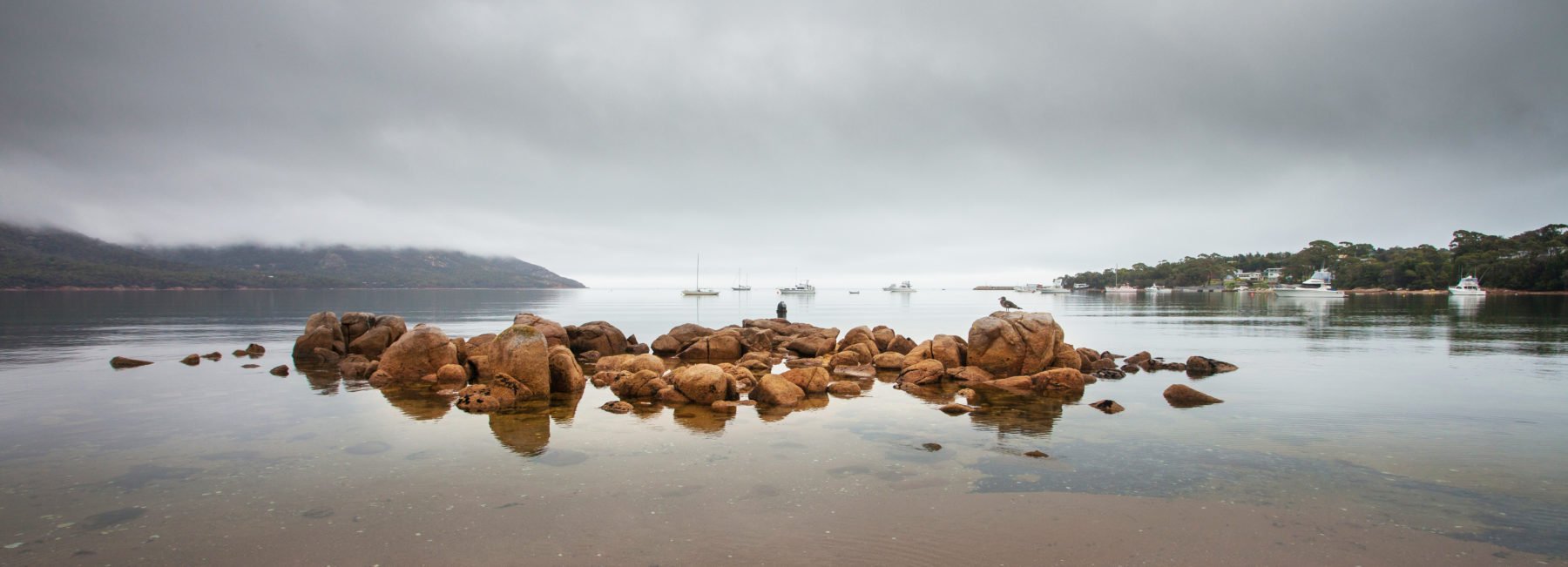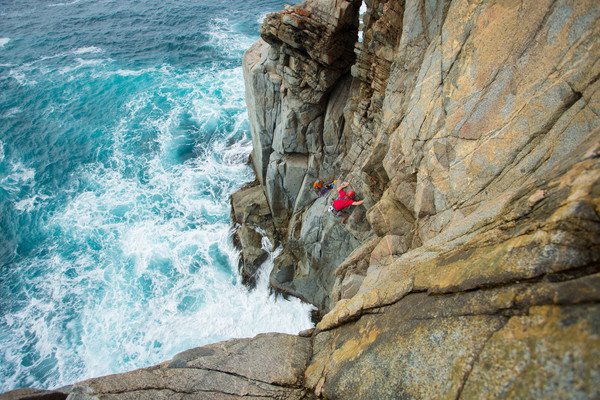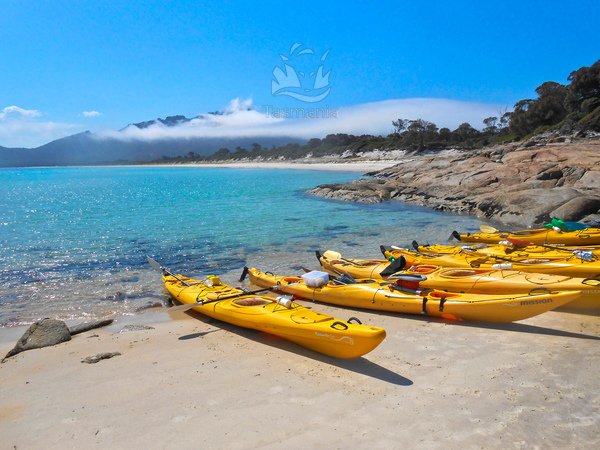Welcome to the Freycinet Peninsula

On a map, Freycinet Peninsula comes close to being a place set apart from the rest of Tasmania, hanging off its east coast like the chain of islands Abel Tasman mistook it for in 1642. It seems somehow fitting, however, because Freycinet’s history is also far removed from the typical Tasmanian tale of convict influence.
Tin, coal and granite have all been mined on the peninsula and its islands. Sealers worked its shores in the early 19th century, followed in 1824 by the first whaling station on Tasmania’s east coast. Up to nine whaling stations operated on the peninsula and on Schouten and Refuge islands, including a station at Wineglass Bay, which at times ran foul with blood.
“When we’d pull the boat up at the southern end of Wineglass, you could still see whale bones down through the water,” remembers local artist Vanessa Quilliam. “There’s so much history here, it’s crazy. Freycinet went from being such a hive of industry and activity, straight to being a national park, and everything was just left alone and not preserved.”
Finding material evidence of all the early activity isn’t easy, though traces exist. A granite quarry scars the base of Mt Mayson. Farmhouses stand behind Cooks Beach, south-west of Wineglass Bay, and Moreys Bay on Schouten Island as reminders of early sheep and cattle grazing.
Even among the relics, however, it’s clear that, almost 100 years since the creation of the national park, nature has fought its way back into the ascendancy. On Schouten Island little penguins shuffle past the remains of whaling tryworks each night. White-bellied sea-eagles command nests as large as rafts, and the largest visitors of all, southern right and humpback whales, are back in force.

WHEN THE FRENCH explorer Nicolas Baudin sailed along Tasmania’s east coast 160 years after Tasman, he corrected the Dutchman’s mapping error, recognising Freycinet as a peninsula and naming it for members of his expedition, the brothers Louis-Henri and Louis-Claude de Freycinet. He also named Fleurieu Bay, a body of water so rich with native angasioysters it was later renamed Great Oyster Bay. Today, it continues to produce oysters in abundance, and oyster farms are the only significant primary industry.
Giles and Julia Fisher own Freycinet Marine Farm, and hold one of six oyster licences on the peninsula. “Oyster Bay fattens oysters beautifully,” says Giles. “It’s like a factory here. You never have to worry about the
environmental conditions; it just does it. It’s got a very strong circular current flow and the water races past, creating a really lovely food delivery system.”
I’ve joined Giles on his punt, Perseverance, skimming across the Swan River estuary loaded with oyster baskets.
Giles steps down into the waist-deep water and begins walking upstream, clipping baskets onto lines. It’s been his routine since they bought the farm in 2005 after almost a decade in the salmon industry on Tasmania’s west coast.
“We genuinely have people clamouring for our oysters,” Giles says. “They seem to have a nice sweet flavour that people enjoy. That’s not our doing – I’d love to take credit for it – it’s the water, and it’s the area we’re in.”
LOOK AT THE RAW infrastructure of Coles Bay, and it could be any small country town: one pub, a post office, one restaurant, no school. It wasn’t until the 1920s that a road reached the town, and it wasn’t sealed for another 60 years. Electricity didn’t arrive until 1963. Yet Coles Bay sits at the doorstep of Wineglass Bay, one of the most instantly recognisable natural features in Australia.
Although tourism has been Coles Bay’s mainstay since Harry Parsons built the first shacks at the beach known as Fisheries in the 1920s, the town retains an understated atmosphere. Only 150–200 people live here permanently, surrounded by weekenders and holiday homes. Out in the bay a small handful of yachts rock gently on their moorings, sheltered from the wind.

ON THE STEEP SLOPES of the Hazards, beside the famed Wineglass Bay Lookout, Rob Connell admires what so few people see from here. “If you stop and take your time to look at the rocks, some of them will take your breath away,” he says. “You’ll see this enormous rock the size of a house balanced on one tiny point. I never get sick of looking at that.”
For this geologist turned park ranger, Freycinet is a dream posting. From across Coles Bay, the bare 370-million-year-old granite of the Hazards glows in pinkish tones created by the feldspar within the rock.
“What we see today are these really distinctive landscapes formed by the juxtaposition of these two rock types – the granite, which is quite bare and eroded with very few trees, and the dolerite soils, which are much more fertile and have heathlands and eucalypts,” Rob says.
As we continue walking, threading between granite boulders, we come to the lookout platform, which hangs off the slopes of Mt Amos. Every year about 100,000 people climb to this spot to marvel at the symmetry of the beach below.
Yet as I look around at Freycinet’s mountains, bush and ocean, it’s clear that even from here, Wineglass Bay is only a small part of the view.
Go beyond…
Eat
Giles and Julia Fisher of Freycinet Marine Farm produce high-quality Pacific oysters and mussels in the clean waters of Coles Bay and invite guests to pop on some waders and harvest oysters straight off the rack, and enjoy an authentic oyster farm tasting experience. Bookings are essential.
Visit: oysterbaytours.com

Climb
Featuring stunning pink granite sea cliffs, Freycinet NP offers some of the best sea-cliff climbing in Tasmania. There’s a variety of climbing to be enjoyed, from sport to trad on multi- and single-pitch routes that will take you high above the sparkling blue waters below.
Visit: mountainbiketasmania.com.au/rock-climbing-tasmania
Ride
Access remote parts of Freycinet NP on a fully guided all-terrain vehicle tour, operating under licence within the park. You’ll travel along bush tracks, climbing hills and winding your way through native eucalypt forest to the coast for breathtaking views. It’s the perfect way to get off the beaten track and enjoy some of Freycinet’s magical destinations far away from the crowds – plus it’s great fun! Half-day and two-hour tours are available.
Visit: all4adventure.com.au

Kayak
Freycinet Adventures offers award-winning guided sea-kayak tours into the heart of Freycinet NP. No prior experience is necessary and all gear is provided. It offers three-hour tours for those with limited time and two-day tours for those wanting to explore further.
Visit: freycinetadventures.com.au




